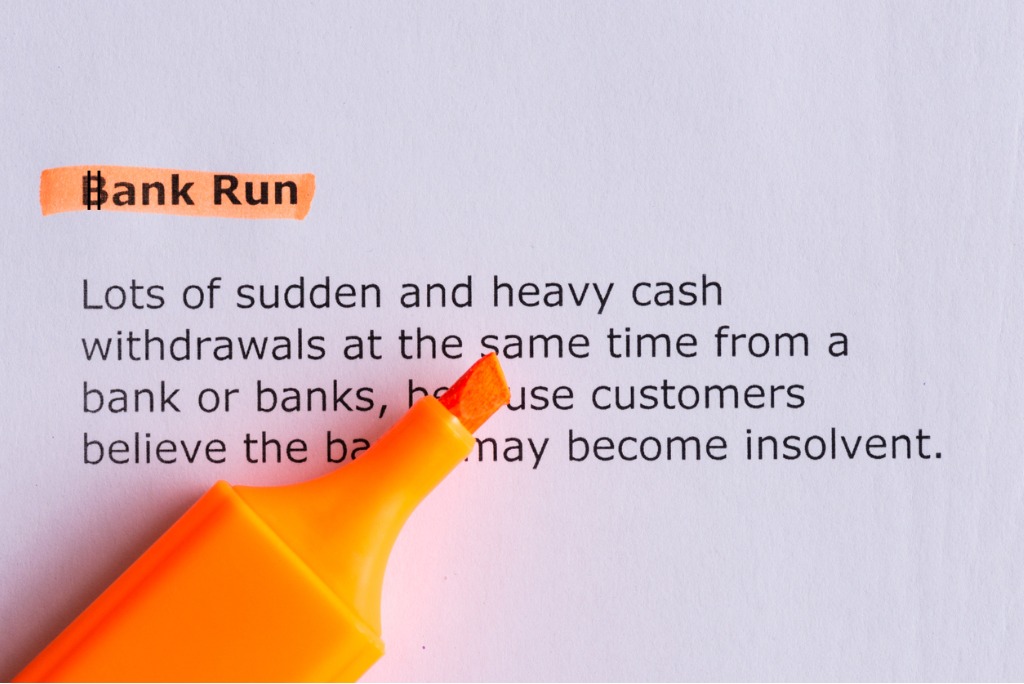[ad_1]
Bitcoin has recently been rising within the midst of widespread banking sector points, prompted by Silicon Valley Bank.
But financial institution runs have been a recurring concern all through historical past, inflicting important injury to the financial system.
The collapse of main banks and the panic that adopted through the Great Depression of the Nineteen Thirties led to the creation of regulatory our bodies such because the Federal Deposit Insurance Corporation (FDIC) to forestall future crises.
While the banking trade has advanced considerably since then, with the rise of on-line banks and fintech firms, the potential for crises nonetheless exists. Recent occasions present this threat could be very actual, prompting many to look to Bitcoin as an answer to avoiding banking crises.
In this text, we’ll discover the historical past of financial institution runs, their affect on the financial system, and the measures taken to forestall them. We will look at examples of financial institution runs all through historical past, together with the Savings and Loan Crisis of the Nineteen Eighties and the 2008 Financial Crisis.
Additionally, we’ll talk about the rise of various banking strategies corresponding to on-line banks and fintech firms, and the potential for future crises within the face of financial uncertainty.
Finally, we’ll look at the function of Bitcoin as a decentralized, borderless various to conventional banking strategies, and its potential in stopping future financial institution runs.
The Great Depression and the Birth of Bank Runs
The Great Depression of the Nineteen Thirties is one of probably the most important occasions within the historical past of financial institution runs.
The inventory market crash of 1929 triggered a wave of panic and uncertainty, resulting in the collapse of many main banks.
People rushed to withdraw their financial savings from banks, fearing that their deposits could be misplaced ceaselessly.
The Collapse of Major Banks and the Panic that Followed
As banks struggled to fulfill the calls for of prospects, many failed to offer their promised payouts.
This additional fueled panic, inflicting folks to withdraw their cash from different banks as properly. This vicious cycle created a domino impact, with banks failing one after one other.
Customers who weren’t capable of withdraw their cash from these banks had been left with no financial savings or monetary safety.
The Role of Government Intervention and the Creation of the FDIC
The Great Depression prompted the U.S. authorities to intervene within the banking system.
In 1933, the Federal Deposit Insurance Corporation (FDIC) was created to insure financial institution deposits and forestall future financial institution runs.
This assured prospects that their deposits could be protected as much as a certain quantity, restoring their confidence within the banking system.
The FDIC’s creation was a big turning level within the historical past of financial institution runs. It created a security web for patrons, guaranteeing that they might not lose their financial savings even when a financial institution had been to fail.
This supplied the general public with much-needed reassurance, stabilizing the banking system and stopping future runs.
Bank Runs within the twentieth Century
The twentieth century noticed the rise of digital transfers and the appearance of trendy banking.
While financial institution runs continued to happen, they took on a special kind within the face of technological developments.
Here are some examples of financial institution runs within the twentieth century and the way they differed from these prior to now.
The Impact of Technology on Banking
The rise of digital transfers made it simpler for patrons to maneuver their cash round. While this made banking extra handy, it additionally made it simpler for financial institution runs to happen.
For instance, in 1996, rumors of monetary instability led to a financial institution run on Britain’s oldest constructing society, the Bradford & Bingley. Customers had been capable of withdraw their financial savings rapidly and simply, contributing to the financial institution’s eventual collapse.
The Savings and Loan Crisis of the Nineteen Eighties
The Savings and Loan Crisis of the 1980s was a big occasion within the historical past of financial institution runs. Over 1,000 banks failed throughout this disaster, inflicting panic and resulting in a wave of financial institution runs.
The disaster was brought on by a mixture of components, together with excessive rates of interest, dangerous investments, and deregulation of the banking trade.
This disaster prompted the federal government to step in and create the Resolution Trust Corporation (RTC) to handle the property of failed banks.
The 2008 Financial Crisis
The 2008 monetary disaster was one other main occasion within the historical past of financial institution runs.
The collapse of Lehman Brothers triggered a wave of panic, inflicting folks to withdraw their financial savings from banks. This led to a freeze in lending, contributing to a worldwide financial recession.
The authorities’s response to the disaster was to bail out failing banks and implement new laws to forestall future crises.
Bank Runs within the twenty first Century
The twenty first century has seen the rise of various banking strategies, corresponding to on-line banks and fintech firms.
While these improvements have introduced many advantages, they’ve additionally created new challenges for the banking trade.
Here are some examples of financial institution runs within the twenty first century and the way they’ve been impacted by technological developments.
The Rise of Alternative Banking Methods
The rise of on-line banks and fintech firms has made banking extra handy than ever earlier than. Customers can simply entry their accounts and switch cash utilizing their smartphones.
However, these improvements have additionally created new challenges for the banking trade.
For instance, in 2018, rumors of monetary instability led to a financial institution run on on-line lender, Tandem Bank. Customers had been capable of withdraw their cash rapidly and simply, inflicting panic and resulting in a brief freeze on withdrawals.
The Impact of the COVID-19 Pandemic
The COVID-19 pandemic had a big affect on the banking trade, inflicting widespread financial uncertainty and resulting in a wave of financial institution runs.
In the early days of the pandemic, folks rushed to withdraw their financial savings from banks, fearing that the monetary system would collapse.
This led to a scarcity of money and a freeze on lending, contributing to the financial downturn.
Silicon Valley Bank and the Start of Another Crisis
Silicon Valley Bank, a distinguished US-based financial institution that focuses on offering monetary companies to the know-how and innovation sectors, not too long ago skilled a financial institution run.
In response to rising instability issues, some of Silicon Valley Bank’s prospects reportedly started withdrawing their deposits en masse, resulting in a liquidity crunch for the financial institution.
The Potential for Future Bank Runs
While the banking trade has develop into safer and secure because the Great Depression, the potential for future financial institution runs nonetheless exists.
Economic uncertainty, technological developments, and different components can all contribute to the chance of financial institution runs.

BTC priced in Silicon Valley Bank shares | BTCUSD on TradingView.com
Bitcoin as a Solution to Avoiding Banking Crises
Bitcoin, the world’s first decentralized cryptocurrency, is changing into an more and more in style various to conventional banking strategies.
As the monetary system continues to face potential crises, increasingly more persons are turning to Bitcoin as a technique to keep away from the danger of financial institution runs and different monetary disruptions.
Origins of Bitcoin
Bitcoin was created in 2009 by an unknown particular person or group utilizing the pseudonym Satoshi Nakamoto.
The first Bitcoin transaction came about in January 2009, when Nakamoto despatched 10 Bitcoins to a developer named Hal Finney. The genesis block of the Bitcoin blockchain features a headline from the UK newspaper The Times, studying “Chancellor on brink of second bailout for banks.”
This headline is believed to be a commentary on the instability of the banking system and the necessity for a brand new, decentralized answer.
Bitcoin’s Advantages in Times of Crisis
Bitcoin gives a number of benefits over conventional banking strategies in occasions of disaster.
Firstly, it’s decentralized, which means that it isn’t managed by any central authority or establishment. This makes it much less weak to authorities intervention and financial instability.
Secondly, Bitcoin transactions are quick, safe, and will be accomplished anonymously, making it a pretty possibility for individuals who want to defend their monetary privateness.
Finally, Bitcoin is a borderless forex, which means that it may be utilized by anybody, wherever on the earth, with out the necessity for intermediaries or authorities laws.
Bitcoin’s Role in Preventing Bank Runs
Bitcoin is more and more being seen as a technique to forestall financial institution runs and different monetary crises.
With Bitcoin, people can maintain their very own property, quite than counting on a financial institution to carry their deposits.
This reduces the danger of a financial institution run, as people can withdraw their property at any time, with out the necessity for a government to approve the transaction.
This decentralization additionally implies that the monetary system is much less weak to financial downturns or authorities interventions, as Bitcoin operates independently of these components.
Conclusion
Bank runs have been a recurring concern all through historical past, inflicting important injury to the financial system.
The Great Depression of the Nineteen Thirties marked the start of financial institution runs and led to the creation of the Federal Deposit Insurance Corporation (FDIC), a turning level within the historical past of financial institution runs.
The twentieth century noticed the rise of digital transfers and the appearance of trendy banking, resulting in new challenges for the banking trade.
The twenty first century has introduced much more adjustments, with the rise of on-line banks and fintech firms, in addition to the potential for crises just like the COVID-19 pandemic.
As the banking trade continues to unravel, it’s seemingly that Bitcoin and different cryptocurrencies will play an more and more vital function within the monetary panorama.
By studying from the historical past of financial institution runs and adapting to new challenges, together with the potential for decentralized cryptocurrencies like Bitcoin, we are able to work in direction of a extra secure and safe monetary future.
[ad_2]
Source link


